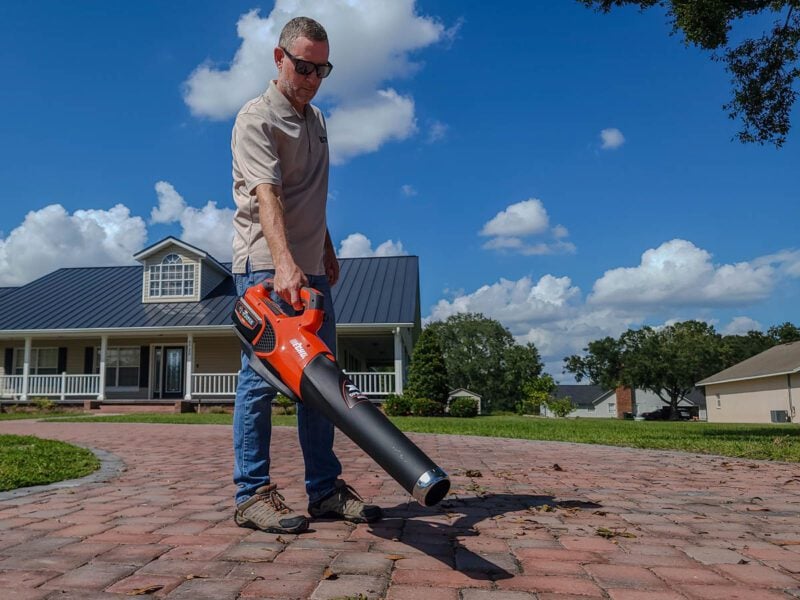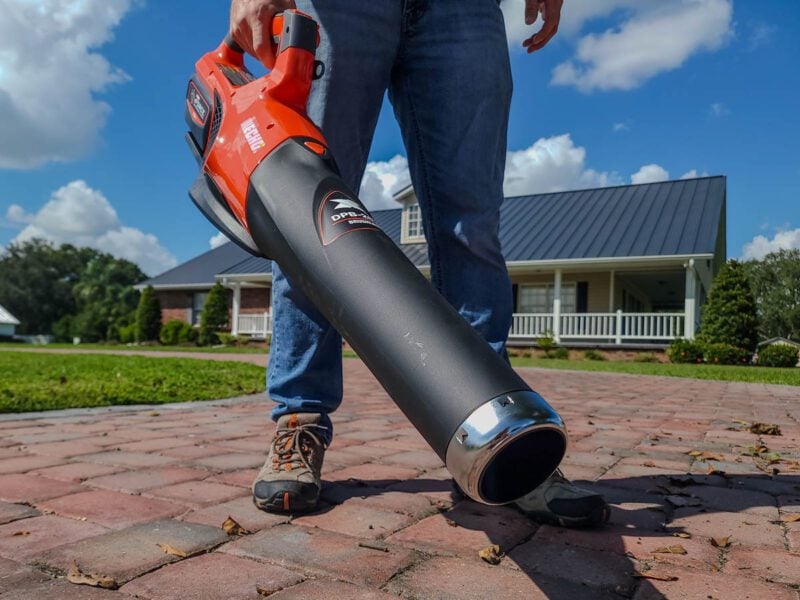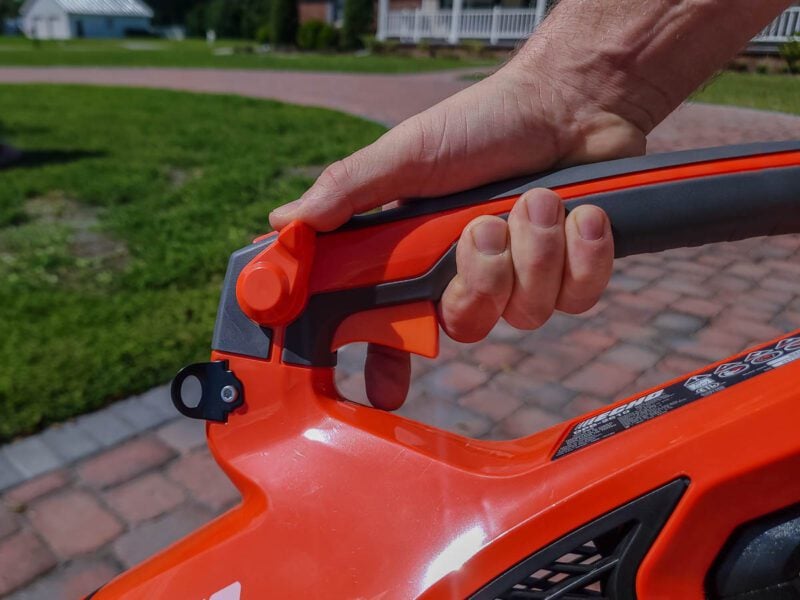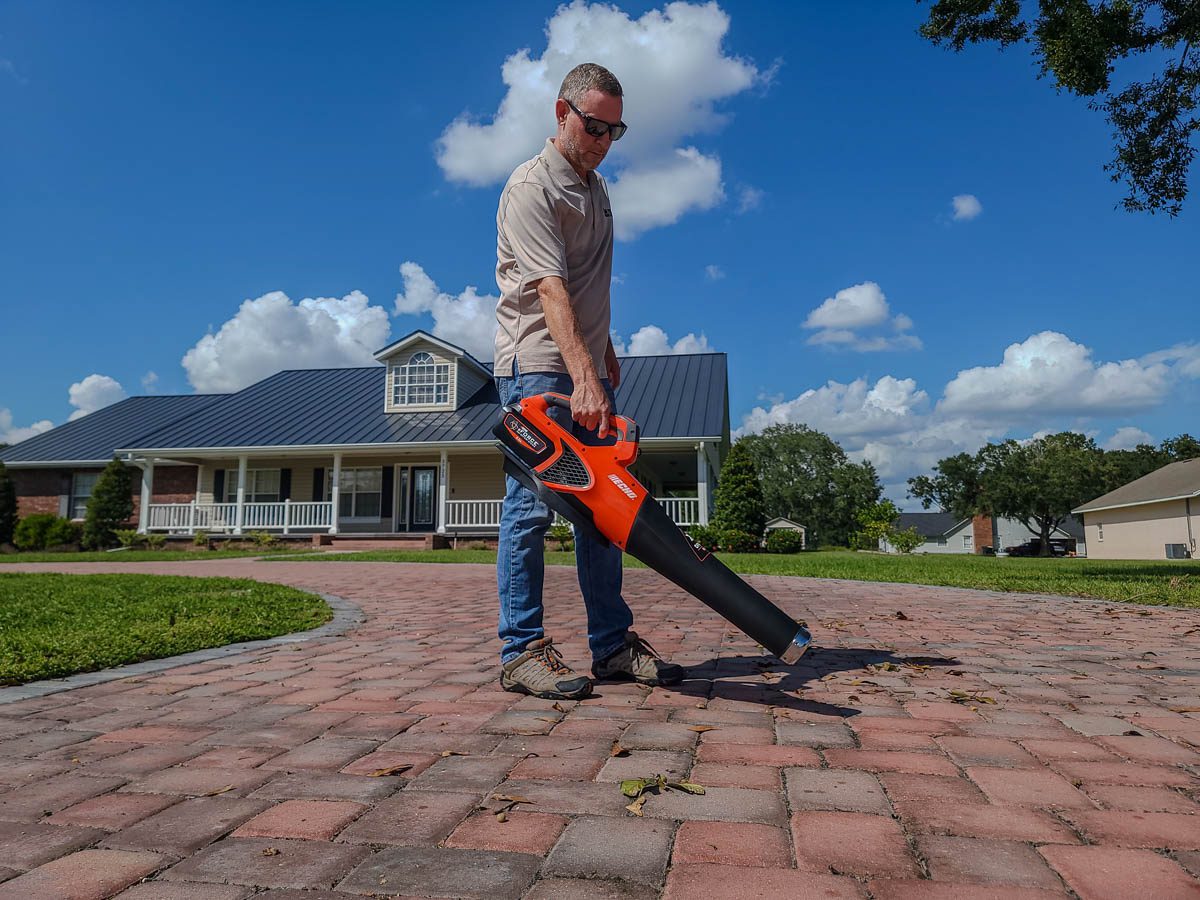Echo’s Strongest Handheld Battery-Powered Blower Also Delivers Impressive Runtime
Today, I’m taking a closer look at the Echo DPB-2610 battery-powered blower—a second-generation model that packs a little more heat and sports some new tech. I’m going to walk you through the key details and tell you what we learned during our testing so you can decide if it’s the right blower for you. I’ll also show you how it compares to the previous model in case you’re considering an upgrade.
Pros
- Excellent ergonomics
- Long runtime
- Metal scraper ring
- Hits the 17 N mark
Cons
- A little louder than most battery-powered blowers
Echo DPB-2610 Battery-Powered Blower Performance

- Max Airflow: 549 CFM
- Max Airspeed: 158 MPH
- Blowing Force: 9.3 N (high), 15.6 N (turbo)
- Runtime: 31 min 15 sec (high), 17 min 44 sec (turbo)
- Noise Level: 93 dBa
- Motor Type: Brushless
Blowing Force
For many folks, battery-powered blowers are becoming the go-to option for their maintenance-free design and effortless operation. But what about power? Well, they’ve got that too, and in many cases, they’re outpacing their gas-powered counterparts.
For Echo, the DPB-2610 is the second battery-powered handheld model on their 56V line, and it features some improved airspeed and CFM ratings over its predecessor. This model has a top air speed of 158 MPH and pushes a total of 549 CFM. But realistically, these are only minor improvements over the DPB-2500’s 151 MPH and 526 CFM. So then why make a new model? More on that in a little bit.
While airspeed and volume are helpful numbers, we rely on Newton force readings to help us determine a blower’s overall power. During our testing, this model produced 9.3 N on high and 15.6 N – 16.2 N with the turbo mode engaged. These results are a little lower than Echo’s stated 17 N, but we expect some variance when we’re testing in Florida’s heat and humidity.
With that in mind, I went out and reran the test, but this time I used an 8.0Ah battery instead of a 5.0Ah battery. This time, I got a max reading of 17.2 N, which just goes to show that battery selection does play a role in total power output.
MaxOut Technology
The real difference between these two models is that the DPB-2610 features Echo’s MaxOut technology. This system allows the blower to squeeze every last drop of power out of the battery, delivering maximum power output until the battery finally gives out.
Runtime
Nailing down exact runtime numbers can be a bit tricky because external factors such as ambient humidity and temperature come into play. Echo claims an average of 25 minutes of runtime on high, but we always like to run our own tests to see how the numbers compare.
For our runtime test, I threw in a freshly charged 5.0Ah battery and set the cruise control to max. The DPB-2610 ran for just over 31 minutes on high, and just shy of 18 minutes with the turbo mode engaged. These numbers make it a top contender in the handheld category in terms of overall runtime.
One thing to keep in mind, though, is that Echo’s blowing force on high is lower than most. It’s one of the reasons they’re able to get more than 30 minutes of runtime. Still, nearly 18 minutes using turbo mode is impressive.
Echo DPB-2610 Battery-Powered Blower Design Notes

- Model: Echo DPB-2610
- Power Source: Echo 56V battery
- Weight: 5.9 lbs (bare tool), 9.9 lbs (with 5.0Ah battery)
- Length: 35.5 in.
Size and Weight
The Echo DPB-2610 weighs in at 5.9 pounds as a bare tool, 9.9 pounds with the kitted 5.0Ah battery, and measures 35.5 inches from tip to tail. This is very similar to its predecessor, the DPB-2500, which clocked in at 5.6 pounds as a bare tool and 9.6 pounds with the same battery.
Ergonomics

Overall, the Echo DPB-2610 has a comfortable and approachable design. The grip sports a good amount of rubber overmold, and it has a very natural forward tilt that makes it easy to maneuver. With that in mind, I wouldn’t recommend using anything larger than 5.0Ah battery, as this puts too much weight towards the back of the tool.
On the grip you’ll find a two-finger variable speed trigger, cruise control dial, turbo button, and a metal tether point so you can pair this blower with a shoulder strap.
Additional Features
- Metal scraper ring
- Compatible with all Echo 56V batteries
Quick Model Comparison: DPB-2610 VS DPB-2500
| DPB-2610 | DPB-2500 | |
|---|---|---|
| Max Airflow | 549 CFM | 526 CFM |
| Max Airspeed | 158 MPH | 151 MPH |
| Stated Blowing Force | 17 N | 17 N |
| Working Weight w/5.0Ah battery | 9.9 lbs | 9.6 lbs |
| Kit Price | $319.99 | $269.99 |
Echo DPB-2610 Battery-Powered Blower Price
The Echo DPB-2610 retails for $199.99 as a bare tool $319.99 as a kit that comes with a 5.0Ah battery and charger. This blower is backed by a 5-year consumer warranty and a 2-year commercial warranty, and the battery gets a 2-year warranty across the board.
The Bottom Line
After getting some hands-on time with the blower, it’s clear that Echo is making some effective strides forward with its battery-powered lineup. Although the DPB-2610 isn’t a drastic step forward in terms of power and performance, the long runtime and MaxOut technology are the real stars of the show.
Looking at the numbers, it’s clear that Echo isn’t shattering any power records compared to some of the battery brands out there, but keep in mind that gas handheld blowers only reach 15 Newtons. This model exceeds that power level. Plus, with 30 minutes of runtime, it is a compelling option for residential users and possibly even Pros looking to supplement their backpack blowers. On top of that, the overall kit value is hard to pass up.



